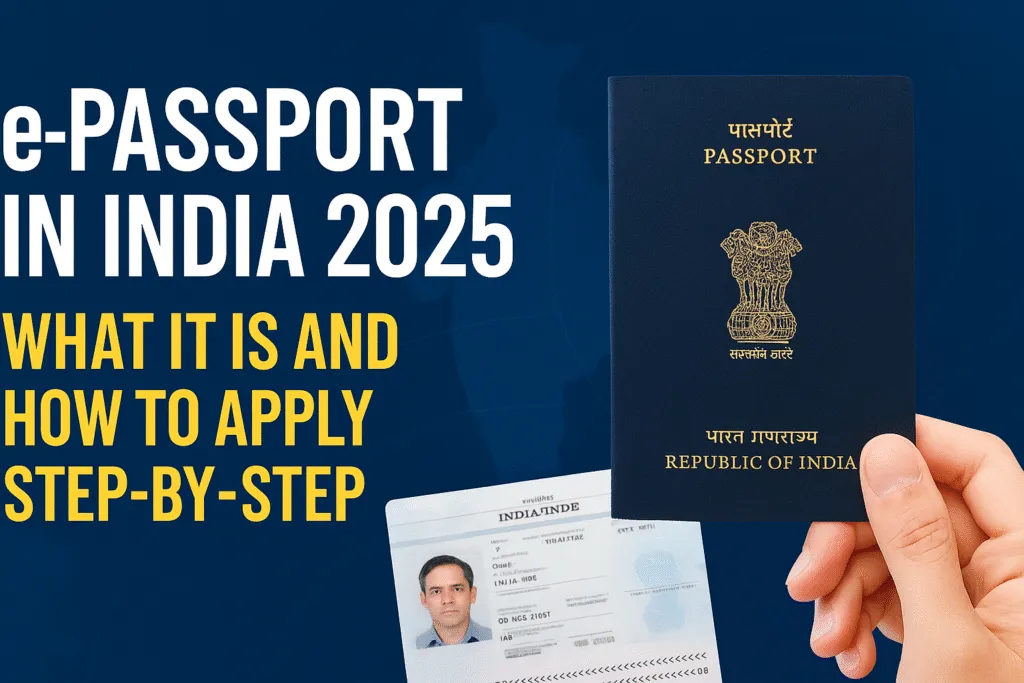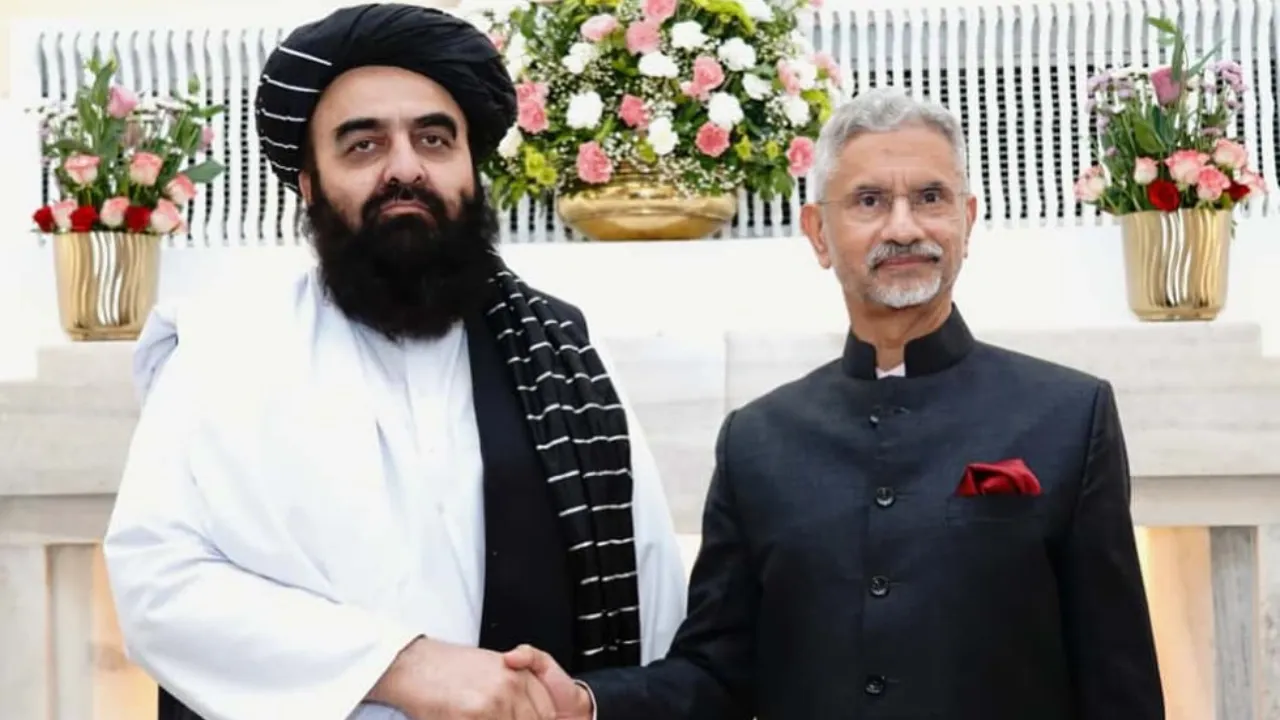Introduction: What Is an e-Passport?
An e-passport, also known as an electronic passport or biometric passport, is a modern version of the traditional passport that includes an embedded microchip. This chip securely stores your personal and biometric information, such as your name, photograph, and digital fingerprints. The goal is to make international travel more secure, faster, and less prone to fraud.
Introduced to align with global standards, the e-passports in India is designed to prevent identity theft and streamline immigration processes. With the rise in digital infrastructure and international threats, e-passports offer a much-needed upgrade to the conventional system.
What makes an e-passport unique is its contactless chip, which can be scanned quickly at automated e-gates, reducing the time spent at immigration counters. The data in the chip is encrypted, making it extremely difficult to tamper with or duplicate. It also allows immigration authorities to verify a traveler’s identity with greater accuracy.
In 2025, India is accelerating the rollout of e-passports as part of its broader push toward digitization. This means applicants applying for a fresh passport or renewing an old one may receive an e-passport by default, especially in major cities. The shift is expected to improve both convenience and national security.
If you’re planning to travel abroad, understanding what an e-passport is and how it works will help you stay ahead. As global travel becomes more tech-driven, the e-passport is no longer a luxury—it’s quickly becoming a necessity.
Difference Between Regular Passport and e-Passport
While both regular passports and e-passports serve the same fundamental purpose—proving your identity and nationality for international travel—the key difference lies in the technology embedded within them. A regular passport is a physical booklet that contains printed personal details, a photograph, and a barcode. In contrast, an e-passport comes with an embedded electronic microchip that stores not only your personal details but also your biometric data.
The e-passport offers an added layer of security that regular passports lack. The microchip inside the e-passport holds encrypted data, including your facial image and sometimes fingerprints, making it much harder to forge or tamper with. On the other hand, a regular passport is more susceptible to duplication and identity theft since it relies solely on printed data.
Another major difference is in how they’re processed at immigration. Regular passports require manual verification, which can be time-consuming. E-passports, however, can be scanned electronically at e-gates, allowing for quicker and more efficient immigration checks. This means shorter queues and faster clearance at many international airports.
Visually, an e-passport looks similar to a regular one, but it usually features a small chip symbol on the front cover, indicating the presence of the embedded chip. This subtle change signifies a big step forward in terms of technology and security.
India’s move to introduce e-passports in 2025 is part of a global trend, with over 100 countries already adopting similar systems. As more airports and immigration systems become compatible with e-passport technology, the gap between traditional and electronic passports will continue to widen—making the e-passport the preferred choice for modern travelers.
Key Features and Benefits of e-Passport in India
The e-passport in India is designed to offer a smarter, faster, and more secure travel experience. At its core, it’s still a passport—but with several enhanced features that bring it up to international standards. Here are some of the most important features and benefits Indian travelers can expect from an e-passport in 2025.
The most notable feature of an e-passport is the embedded microchip on the back cover page. This chip securely stores your personal details, including name, date of birth, passport number, and a digital version of your photograph. It also contains biometric data, such as your facial recognition profile and, in some cases, fingerprints. All this data is encrypted, making it almost impossible to forge or tamper with.
Security is a major benefit. The chip makes identity theft and data manipulation extremely difficult. In addition, the e-passport follows the ICAO (International Civil Aviation Organization) standards, ensuring global compatibility and acceptance.
Another key advantage is faster immigration processing. With e-passports, travelers can pass through automated e-gates at many international airports, avoiding long queues and manual verification. This feature is especially helpful for frequent flyers and business travelers.
Durability is also improved. E-passports are made with enhanced material quality, making them less prone to wear and tear compared to traditional booklets.
From a national perspective, e-passports help improve border security and reduce fraud cases. For individuals, they mean quicker processing, stronger identity protection, and a seamless travel experience.
As India continues to roll out e-passports in 2025, travelers can expect a significant upgrade in how they move across borders—efficient, secure, and future-ready.
Who Is Eligible for an e-Passport in India?
In India, anyone who is eligible for a regular passport is also eligible for an e-passport. There are no special conditions or extra requirements. Whether you are applying for a passport for the first time or renewing an existing one, you may receive an e-passport if it is available at your local passport office.
This includes all categories—adults, minors, senior citizens, and even holders of diplomatic or official passports. The Government of India began the rollout of e-passports in selected cities and is gradually expanding the service nationwide. Cities like Delhi, Chennai, Hyderabad, Nagpur, and Jaipur are already issuing e-passports, with many more locations expected to be covered by the end of 2025.
It’s important to note that you don’t need to apply separately for an e-passport. If you visit a Passport Seva Kendra or Post Office Passport Seva Kendra that has the infrastructure for e-passport issuance, your passport will automatically be the chip-enabled version. The process, documents, and fees remain the same as for a regular passport.
Also, there’s no need to replace your existing passport if it’s still valid. E-passports are being issued on a rolling basis, mostly during new applications or re-issuance. Your current passport will remain valid until it expires, and you can apply for an e-passport during your next renewal.
In short, if you’re an Indian citizen applying for or renewing a passport in a region that supports the new system, you’re already eligible for an e-passport. No extra forms, no special application—just a more secure and efficient travel document by default.
How Does an e-Passport Work? (Technical Overview)
An e-passport works by integrating advanced chip technology with traditional passport features to enhance both security and convenience. The core of an e-passport is a small, embedded electronic microchip located in the back cover of the passport booklet. This chip securely stores your personal and biometric information, which can be read electronically at immigration checkpoints.
The chip follows international standards set by the International Civil Aviation Organization (ICAO). It contains a digital version of the passport holder’s photograph, full name, date of birth, passport number, and nationality. In some cases, it may also include biometric data such as fingerprints or iris scans, depending on the issuing country’s policy.
When you pass through an e-gate or an immigration kiosk, the scanner reads the data stored on the chip using Radio Frequency Identification (RFID) technology. The machine compares this data with what’s printed on the passport and cross-verifies it with live biometric scans, such as facial recognition. This allows for faster processing and stronger identity verification.
To prevent unauthorized access, the data on the chip is protected using digital encryption and digital signatures. This means only authorized systems can read the chip, and any attempt to tamper with or clone the data will be flagged during authentication.
In India’s e-passport system, the chip is designed to last for the passport’s full 10-year validity and withstand regular handling. It also includes features like Basic Access Control (BAC), which ensures the chip can’t be read remotely without physically opening the passport.
In summary, an e-passport works like a digital security upgrade to your regular passport. It makes international travel more secure, reduces the risk of fraud, and speeds up the immigration process with its contactless verification technology.
Step-by-Step Process to Apply for an e-Passport in India (2025)
Applying for an e-passport in India is straightforward and similar to the process of getting a regular passport. The key difference is that if your regional passport office is equipped for e-passport issuance, you’ll automatically receive a chip-enabled passport.
Step 1: Register Online
Start by visiting the official Passport Seva Portal. Create an account or log in if you already have one.
Step 2: Fill Out the Application
Choose the relevant option—“Fresh Passport” or “Re-issue of Passport.” Complete the online form with accurate details.
Step 3: Pay the Fee and Book Appointment
Pay the applicable fee online. Once the payment is successful, book your appointment at the nearest Passport Seva Kendra (PSK) or Post Office PSK.
Step 4: Save the Appointment Confirmation
Download or print your appointment slip, which contains your Application Reference Number (ARN) and visit details.
Step 5: Visit the PSK/POPSK
On your appointment day, carry all original documents. At the center, your photo and biometric data (like fingerprints) will be captured.
Step 6: Police Verification
After your appointment, a police verification process will be initiated. Thanks to digital tools, this step is now faster and more streamlined in many cities.
Step 7: Receive Your e-Passport
Once approved, your e-passport will be printed and dispatched to your registered address via post.
Currently, e-passports are being issued in selected cities, but the rollout is expanding across India. You don’t need to specifically apply for an “e-passport”—if the infrastructure is available, you’ll receive one by default.
This process ensures a more secure, tech-enabled travel document without adding any complexity for the applicant.
Documents Required for e‑Passport Application
Applying for an e-passport in India requires the same documentation as a regular passport. There are no additional documents specific to the chip-enabled format. However, accuracy and completeness are crucial to ensure a smooth application process.
1. Proof of Identity
You can submit any government-issued ID that includes your name and photograph. Common options include Aadhaar card, PAN card, voter ID card, or driving license.
2. Proof of Address
Documents such as an Aadhaar card, electricity or water bill, bank statement, rental agreement, or employer-issued certificate are accepted. Ensure that your current address matches the one mentioned in the application form.
3. Proof of Date of Birth
A birth certificate is mandatory for individuals born on or after October 1, 2023. For those born before that, options include a PAN card, Aadhaar card (if it has a valid DOB), school leaving certificate, or Class 10 marksheet.
4. Existing Passport (For Re-issue)
If you’re applying for re-issuance, carry your old passport and photocopies of its first and last pages, any observation pages, and the page showing ECR/Non-ECR status.
5. Documents for Minors
For children, you’ll need their birth certificate, parents’ ID and address proof, and a declaration of consent from one or both parents. A recent passport-size photo of the child may also be required.
6. Photographs
While biometric data is captured at the center, it’s wise to carry two recent passport-size photos, especially for minors or in special cases.
Always carry original documents along with one set of self-attested photocopies. Proper preparation can help you avoid delays and ensure your e-passport application is processed without issues.
Fees and Processing Time for e-Passport (2025)
The fees for an e-passport in India are the same as for a regular passport since the chip-enabled feature does not come with an extra charge. For adult applicants, the cost for a 36-page passport booklet is ₹1,500, while the 60-page option is ₹2,000. Minors under 18 years can apply for a 36-page passport at a reduced fee of ₹1,000, valid for five years. If you need your passport urgently, you can opt for the Tatkaal service, which involves an additional fee of around ₹2,000 on top of the base price.
Processing times have improved significantly with the introduction of Passport Seva Programme 2.0. After submitting your application and completing biometric verification at the Passport Seva Kendra or Post Office Passport Seva Kendra, police verification usually takes about 5 to 7 working days thanks to digital processes. Once verification is complete, your e-passport is printed and dispatched, which generally takes another 3 to 10 days.
In most cases, applicants receive their e-passport within 2 to 3 weeks of their appointment date. If you choose the Tatkaal service, this timeline shortens to approximately 8 to 10 working days, depending on local conditions.
The application process itself remains straightforward: register online, fill out the form, pay fees, schedule an appointment, submit documents, and complete biometrics. If your passport office offers e-passport services, you will automatically get the electronic passport without needing to select it separately.
In summary, the e-passport offers enhanced security and technology without increasing your costs or processing time, making it a convenient choice for all Indian travelers in 2025.
How to Track Your e-Passport Application Status
Tracking your e-passport application in India is simple and convenient, ensuring you stay updated throughout the process. Once you submit your application and attend your appointment at the Passport Seva Kendra or Post Office Passport Seva Kendra, you receive an Application Reference Number (ARN). This ARN is your key to checking the status online.
To track your application, visit the official Passport Seva Portal and enter your ARN along with your date of birth. The portal provides real-time updates about your application stage—whether your documents are under verification, if police verification is complete, or if your passport is ready for dispatch.
In addition to the online portal, you can also track your application via SMS by registering your mobile number during the application process. Regular SMS alerts notify you about important milestones, such as appointment confirmation, police verification completion, and passport dispatch.
If you prefer, you can call the Passport Seva helpline and provide your ARN to get the latest status update from customer support. This is helpful if you have specific queries or face technical difficulties online.
Once your e-passport is dispatched, you will receive a tracking number for the courier service delivering your passport. Using this tracking ID, you can monitor the delivery progress until the passport reaches your doorstep.
Overall, the tracking system offers transparency and peace of mind, allowing you to monitor your e-passport application from start to finish. With these tools, you can plan your travel better and avoid unnecessary follow-ups or delays.
Safety and Security Aspects of e-Passports
e-Passports are designed with advanced safety and security features that significantly improve upon traditional passports. The embedded electronic microchip plays a central role in protecting your identity and personal information. This chip securely stores biometric data such as your photograph, fingerprints, and other personal details, all encrypted to prevent unauthorized access.
One major security advantage is the use of encryption and digital signatures, which make it extremely difficult for anyone to tamper with or forge your passport data. This helps prevent identity theft and fraud, which are common risks with physical documents.
The chip also supports Basic Access Control (BAC), meaning it can only be read by authorized passport readers after verifying physical access to the passport. This prevents remote skimming or unauthorized scanning of your personal data.
Many e-passports include biometric verification steps, such as facial recognition or fingerprint matching, during immigration checks. This ensures that only the rightful passport holder can use the document, enhancing border security worldwide.
Additionally, the passport booklet itself is built with special materials and security features like watermarks, holograms, and UV-sensitive ink. These make it easier for officials to spot counterfeit passports.
India’s adoption of e-passports aligns with international standards set by the International Civil Aviation Organization (ICAO), ensuring global compatibility and a high level of security.
In summary, the e-passport combines cutting-edge technology and physical security features to protect travelers from fraud, enhance identity verification, and make international travel safer and more reliable.
Availability: Where Are e-Passports Being Issued in India?
As of July 2025, India has initiated the phased rollout of e-passports under the Passport Seva Programme 2.0. These chip-enabled passports are currently being issued in select cities, with plans for nationwide availability by mid-2025.
Cities Where e-Passports Are Currently Available:
- Nagpur
- Bhubaneswar
- Jammu
- Goa
- Shimla
- Raipur
- Amritsar
- Jaipur
- Chennai
- Hyderabad
- Surat
- Ranchi
- Delhi
These locations were selected based on high application volumes and existing infrastructure readiness. The government aims to expand e-passport services to all Passport Seva Kendras across the country by mid-2025.
To apply for an e-passport, visit the official Passport Seva Portal, register or log in, fill out the application form, and schedule an appointment at a Passport Seva Kendra offering e-passport services. During your appointment, biometric data will be collected, and upon verification, your e-passport will be dispatched to your registered address.
Please note that existing passport holders are not required to switch to an e-passport. Your current passport remains valid until its expiration date. The e-passport is an optional upgrade for new applicants or those renewing their passports.
e-Passport for Minors and Senior Citizens – What’s Different?
When it comes to e-passport, minors and senior citizens have some specific provisions to make the application process easier and more convenient.
For minors (below 18 years), the passport is typically issued with a validity of 5 years instead of the usual 10 years for adults. Parents or legal guardians must provide consent and submit additional documents such as the child’s birth certificate and proof of parentage or guardianship. Biometric data collection like fingerprints may be exempted for very young children, usually under 5 years of age, but a recent photograph is still required. The application process also involves submitting a declaration or annexure confirming parental consent.
Senior citizens (usually defined as those above 60 years) benefit from a simplified process in some cases. For example, police verification may be more streamlined or sometimes waived if the applicant has a clean record and holds certain government-issued identity proofs. Senior applicants enjoy the same validity period of 10 years for their passports as other adults, and they must provide standard documents including proof of identity, address, and date of birth.
In both cases, biometric data is securely stored on the embedded chip in the e-passport, enhancing security while respecting certain exemptions. Overall, these provisions ensure that both minors and senior citizens can apply for and receive their e-passports with fewer hurdles, making travel documentation accessible to all age groups.
Conclusion: Is It Worth Switching to an e-Passport in 2025?
Switching to an e-passport in 2025 is definitely worth considering for anyone applying for a new passport or renewing an existing one. The e-passport offers enhanced security features thanks to the embedded electronic chip that stores biometric data securely, making it much harder to forge or tamper with. This added layer of protection not only safeguards your identity but also streamlines verification processes at international borders.
Additionally, e-passport align with global standards, ensuring smoother travel experiences worldwide. With many countries upgrading their immigration systems to support e-passports, having one can speed up entry and exit procedures, reducing waiting times.
The application process for an e-passport in India is similar to that of a regular passport, without any additional cost or extra steps. Plus, India is rapidly expanding its e-passports issuance to more cities, making it accessible to a growing number of citizens.
In summary, the benefits of improved security, global acceptance, and future-ready technology make switching to an e-passports a smart choice in 2025. It’s a convenient upgrade that protects you better and makes your international travel hassle-free. If you’re planning to apply for or renew your passport this year, opting for an e-passport is a forward-thinking decision.
Also Read: Top 10 AI-Powered Apps That Make Your Life Easier (2025 Edition)
FAQs About e-Passports in India (2025)
1. What is an e-passport?
An e-passport is a biometric passport embedded with an electronic chip that securely stores the holder’s personal and biometric information for enhanced security and faster processing at borders.
2. Is there an extra fee for an e-passports in India?
No, the fee for an e-passport is the same as a regular passport. There is no additional charge for the electronic chip feature.
3. Can I apply for an e-passports online?
Yes, the application process is online through the Passport Seva Portal. You fill the form, book an appointment, and visit the Passport Seva Kendra for biometric data collection.
4. Are e-passports mandatory in India?
Currently, e-passports are optional. You can still apply for a regular passport, but the government is gradually expanding e-passport services.
5. How long does it take to get an e-passport?
Typically, it takes 2 to 3 weeks from the appointment date. Urgent Tatkaal services can deliver within 8 to 10 working days.
6. Can minors get e-passports?
Yes, minors are eligible for e-passports with some special provisions like shorter validity and parental consent.
7. Will my current passport become invalid after e-passports are introduced?
No, existing passports remain valid until their expiry. You don’t have to switch to an e-passport unless renewing or applying fresh.
8. How can I track my e-passports application status?
You can track it online using your Application Reference Number on the Passport Seva Portal or receive updates via SMS.













